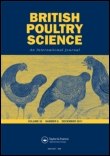Adres van het centrum waar
Informatie voor deelnemers aan het onderzoek “Losartan en Marfan syndroom” Coördinerend onderzoeker: Dr. M. Groenink, cardioloog AMC Amsterdam Artsonderzoekers: F. S. van Dijk, artsonderzoeker VUmc Amsterdam T. Radonic, artsonderzoeker AMC Amsterdam Academisch Medisch Centrum Meibergdreef 9 1105 AZ Amsterdam VU Medisch Centrum Amsterdam De Boelelaan 1117 1081 HV Ams
 This article was downloaded by: [UNAM Ciudad Universitaria]On: 14 February 2013, At: 11:09Publisher: Taylor & FrancisInforma Ltd Registered in England and Wales Registered Number: 1072954 Registered office: MortimerHouse, 37-41 Mortimer Street, London W1T 3JH, UK
British Poultry Science
This article was downloaded by: [UNAM Ciudad Universitaria]On: 14 February 2013, At: 11:09Publisher: Taylor & FrancisInforma Ltd Registered in England and Wales Registered Number: 1072954 Registered office: MortimerHouse, 37-41 Mortimer Street, London W1T 3JH, UK
British Poultry Science